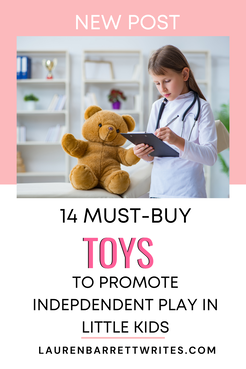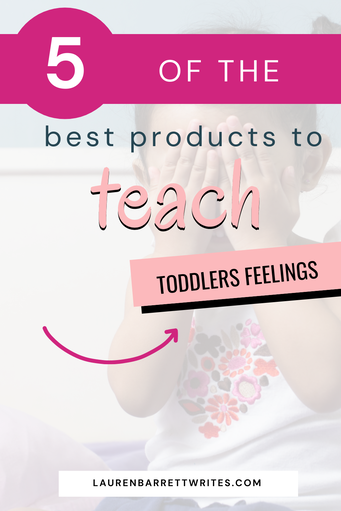|
We are at that age when my son has a lot of BIG feelings. And as a parent, my role is to be there to make sure he isn’t navigating these emotions alone.
Clinical psychologist and mom of three, Dr. Becky from Good Inside, says that oftentimes toddlers don’t find the actual feeling scary, but have a hard time when they think they are ALONE with the feeling. That’s when they might act out - hit, scream, throw, bite. It’s during those times when they are having trouble identifying and regulating those BIG feelings. So the best thing we can do as parents is to consistently talk about their feelings and give them names for what they are experiencing daily. Not only do we have to talk about their feelings, but we need to show them and help them practice identifying and regulating their emotions. To do this, you don’t need a fancy subscription to a Feelings Toolkit or the most expensive product advertised on social media. All you need are products found around your house or the local library to help you get started with teaching your toddlers about their feelings.
Lauren Barrett Writes is a participant in the Amazon Services LLC Associates Program, an affiliate advertising program. As an Amazon Associate, I earn from qualifying purchases. Read more about these links in my disclosure policy.
The 5 Best Products - Let’s Go
1. A Mirror
Mirror, Mirror on the wall who is the happiest of them all? It’s you! That’s right, a mirror is a great way to teach about feelings. Break out a small handheld mirror and get to work on making faces for each feeling with your little one. All those mirror selfies will come in handy for this one. Hold the mirror up to your toddler's face and say, “Show me your sad face.” Together, make your most exaggerated sad face. For added teaching moments, give a scenario followed by what face you would make if that situation actually happened. “Your ice cream cone dropped to the floor. Oh no! Show me your sad face.” “You got a new toy for your birthday. Yay! Show me your happy face.” This works wonders because your toddler not only sees you modeling situations and the faces you make, but he can see his own face too and recognize what his emotions look like. You’ll have a blast with this one.
2. Books
Books are one of the best ways to teach little kids about their feelings. You can either buy a book directly related to teaching emotions or read any book and point out the character’s feelings. Ask wh- questions as you read. No worries if your child is too young to answer back. Ask the question. Wait. And then answer for your toddler. Who is feeling sad? What happened to the boy? Why do you think he is so happy? _______ happened. How do you think that makes her feel? _______________ happened. What do you think will happen next? Some of the books I like related to feelings are…
3. Dolls/Stuffed Animals
Every kid probably has a handful of dolls and stuffed animals lying around. In fact, we got our son a little stuffed doll that looks like him that we named Lil’ Hen. Use these dolls or stuffed animals to act out situations. For example, Henry has been potty training, and he has been a little (and by a little I mean very) afraid of pooping on the toilet. I use his Lil’ Hen doll or favorite stuffed animal (Mr. Penguin) to act out trying to poop on the toilet. I talk about how they were scared beforehand but afterwards felt proud. Henry watches me act out these scenarios with fascination. If your toddler has been having an issue with hitting or biting, act it out with stuffed animals. Have one get angry and hit the other. Then, talk through how the animal that got hit would feel afterwards. I really like the stuffed animal WhatsItsFace because you can change the face of the animal to match the emotion. It has a happy, angry, sad, surprised, sleepy, and excited face. Act out each of these emotions and have your children find the face to match. As your kids grow, they can act out situations to match the face. Let your creativity loose with stuffed animals and dolls when it comes to emotions.
4. Markers and Construction Paper
Break out the markers and construction paper and draw different faces with different emotions. Point them out and have your toddler guess which feeling the face is conveying. You can even teach them that different colors convey emotions. For example, angrily scribble red lines everywhere and explain how red can mean anger. Or use green to represent envy or disgust. Then, let your little one take over with the markers and paper. You can give them prompts like: “How would you draw someone who is sad?” or let them have free reign. But whatever you do, do not correct them or tell them what to draw. There is no right or wrong here.
5. Music
Using music to teach emotions might be a little advanced for younger toddlers to truly grasp, but it is a great teaching method to help them understand the abstractness of feelings. Play different tempos of music and talk about what emotions they represent. For example, a head-banging, heavy metal tune could mean anger while the gentle flow of a babbling brook can mean peaceful, content, happy. Next, allow your children to make their own music with real instruments or makeshift ones. Banging loudly on pots of pans can be used to convey fury or anger. Just like with the markers, let your kids take over with this one.
Wrapping It Up
Whichever way you decide to use, remember that there is no wrong way to teach emotions as long as you are talking about them consistently and truthfully. Discovering their feelings is BIG for toddlers, and they don’t want to be left alone with them. Start by talking about them once a day or pick one of these methods to try each day. You don’t have to spend hours discussing feelings at length. Just 5-10 minutes here and there. You’ll discover a big difference once you all start talking about them more. A happier kid with more positive behaviors. For a video on how I am using sign language to teach emotions click here. And for the checklists I use when my toddlers have BIG emotions click here. For for information on my parenting book and guide click here.
0 Comments
Leave a Reply. |
Categories
All
|
Proudly powered by Weebly





 RSS Feed
RSS Feed